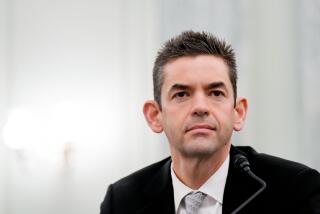Aircraft Builders Still a Strong Presence in Area
- Share via
A decade after the end of the Cold War sent weapons-systems makers into a tailspin, the Valley remains flush with aerospace businesses--nearly 150 by one recent count.
The big hitters, such as Lockheed and Hughes, have closed shop here. Others were sold to distant owners--notably Rocketdyne, sold by Rockwell to Seattle-based Boeing.
For the record:
12:00 a.m. March 22, 2000 For the Record
Los Angeles Times Wednesday March 22, 2000 Valley Edition Metro Part B Page 3 Zones Desk 1 inches; 20 words Type of Material: Correction
Hughes Facility--The year Hughes Missile Systems closed its West Hills location was incorrect in a story Tuesday. The facility closed in 1994.
While some of the companies that remain are battling for survival, others say they are finally rebuilding after the deep aerospace recession of the early and mid-1990s.
In Sylmar, Pentagon contractor Ocean Systems discovered an abundance of new clients simply by turning its focus overseas. In Sunland, Wallace Lee and his six employees work from sunrise to sunset making anything and everything for industries ranging “from pencils to airplanes.” And in Burbank, a struggling machine shop called Quantum Manufacturing looks to Hollywood and amusement parks for its future.
Waves of funds from the U.S. government and commercial aircraft builders kept the San Fernando Valley’s aerospace firms flush and static for decades. Today, though, local aerospace companies find they must scramble for new markets, along with everybody else, because to wait for the old business to return may mean to shrivel up and die.
“I think this is a historical time in this industry,” said David Goodreau, owner of Quantum and president of the Small Manufacturers Assn. of California. “It’s going to be critical for companies to diversify aerospace, if anything, in the region, [or else] it’s going to continue to shrink.”
*
The money pot dried up about 10 years ago. With the disintegration of the Soviet Union--and the disappearance of the security threat it represented--Congress reapportioned funds once funneled into space and defense programs. Much of the work had been done in the Valley, where federal funds ultimately financed innumerable mortgages and sent generations of children off to college.
Then the commercial side of aerospace also began to slim down. Commercial airline companies realized they could make more money simply by purchasing fewer new planes and keeping the old ones in better shape, said Jon Kutler, president of Quarterdeck Investment Partners, a Los Angeles-based investment bank. They also pushed manufacturers such as Boeing to deliver less-expensive planes. The manufacturers, in turn, put new pressures on their subcontractors. Eventually, this filtered down to Valley companies, small and large, which either trimmed their costs or collapsed.
“The old Southern California days of contracts that are there for the picking are gone,” Kutler said. “The Valley’s once-dominant [aerospace] position has largely dissipated.”
Across the nation and California, though, aerospace no longer looks like its old powerhouse self. Industry sales topped $160 billion in the second quarter of 1999, about $20 billion more than a previous, 1991 peak, according to the Aerospace Industries Assn. of America. Yet employment is down, pointing to the industrywide winnowing that left heftier contracts in ever-fewer hands.
Aerospace employment hit a recent high in 1989, with 1.2 million people on the payrolls, according to the association. That dropped to about 800,000 employees by the third quarter of 1999, the most recent period available, the association reported.
*
Of the work that is available, less of it is ending up in California. The Golden State received about 20% of all the nation’s major defense contracts in 1994, according to the Defense Department. Five years later, only 15% of all prime contracts went to California companies, the department reported.
The Valley is rife with examples of these statistics. Lockheed once brought millions of dollars worth of Pentagon contracts to Burbank, that is, until it merged with Marietta in 1989 and began the slow process of shifting its operations to Georgia and elsewhere. Hughes Missile Systems, once one of the largest employers in the Los Angeles area, closed up shop at its 86-acre West Hills site in 1984.
Major companies that remain look and feel different today even if their name has stayed the same. TA Manufacturing, for instance, a longtime division of Esterline Technologies of Bellevue, Wash., employs 230 people at its plant in Valencia. The company moved there from Glendale two years ago.
TA has seen “tremendous growth” in the past five years, powered by acquiring other companies, said Fred Gardner, vice president and general manager.
“That’s been the marching orders,” he said. “The [aerospace] market’s been shrinking, seriously shrinking.”
Rocketdyne, once a division of Seal Beach-based Rockwell International, now belongs to Boeing. The company employs 4,000 people at its headquarters in Canoga Park and other Valley-area facilities, plus another 1,000 around the country, said spokesman Daniel Beck.
That’s down from a peak of 26,000 workers in the 1960s, but up from the low of 2,000 in the early 1990s, he said.
The revival is fueled by increased demands for its rocket engines, which boost into the stratosphere everything from space stations to commercial satellites, Beck said.
“We’re on the verge of a real exciting time in commercial space, but at the same time, it’s also going to be globally competitive,” Beck said.
*
Still, Beck said, the company tries to farm out as many contracts as possible to Valley firms, because many of them are still struggling. Generally, it’s toughest for the smaller companies, which cannot afford to slash costs or switch strategic direction the way major corporations can.
Herb Hayward, owner of Astrodyne Inc. in Chatsworth, could write a book on that subject.
“It just keeps getting tighter and tighter out there,” said Hayward, who pared his work force by 20 people, down to a total of 30, during the past year. He would love to sell the business, which makes hydraulic units for commercial and government aerospace clients, if only someone would make him an offer he could afford to accept.
“There’s less and less work out there, and people are trying to get it done cheaper and cheaper,” he said.
In Sunland, Wallace Lee stays afloat by never sitting still. Working five 12-hour days a week, plus half-days on Saturdays, he employs a spare six people at his Precision Engineered Products.
“I do electronics for the studios,” said Lee, who estimates he now actively manufactures 30 of the 140 products for which he carries patents. “We make special covers for jet engines, to keep the dirt out. We make special hinges for airplanes all over the world.”
*
Ocean Systems of Sylmar, a division of New York-based L-3 Communications, saw its Pentagon business slow to a trickle in the mid-’90s. The company made acoustic undersea warfare systems, but suddenly the United States had other spending priorities. Still, it took a few years of dropping profits before executives decided they needed to make radical changes. Luckily, they could afford to do so.
Since Ocean Systems began creating products for foreign markets, the company has grown by 45% and now employs 15,000 people, said Stever Schorer, the company’s president and general manager. Ocean Systems was losing money only three years ago, but profits are up 1,700% since then, with sales reaching $1.4 billion last year, he said.
“Until you see the ship sinking, the burning platform, you don’t realize you’ve got to do something different,” Schorer said.
Of course, it’s easier to do something different with the backing of a major corporation and the help of thousands of employees. Goodreau, owner of Quantum Manufacturing, enjoys neither of those luxuries at the precipice of his crisis.
“Business is down 70% over what it was two years ago,” said Goodreau, whose Burbank machine shop does work for Boeing’s 747 airplane, and who attributes the business downturn to Asia’s financial troubles.
*
A couple of years ago, Goodreau employed 17 people. Now it’s down to eight, including part-timers. As a result, “we’re doing everything we can to move out of aerospace” and diversify into other fields, such as the movie business, medicine and rides at amusement parks, he said.
It’s not easy going. When Quantum goes out on jobs such as repair and maintenance work for film sets, it meets an “anywhere-but-aerospace attitude” from people who think all such firms are inefficient and hopelessly bureaucratic, Goodreau said.
Still, Goodreau and Quantum trudge forward on this rocky path because, simply, they fear there is no other one.
“If there’s one thing I’m convinced of, it’s that the 80-20 rule applies,” he said. “Eighty percent of all progress comes from 20% of the people.
“Eighty percent of the companies are stuck in a backward, older culture, and they don’t understand how to take advantage of what’s happening in the marketplace,” he said. “I think a good portion will die.”
More to Read
Inside the business of entertainment
The Wide Shot brings you news, analysis and insights on everything from streaming wars to production — and what it all means for the future.
You may occasionally receive promotional content from the Los Angeles Times.










